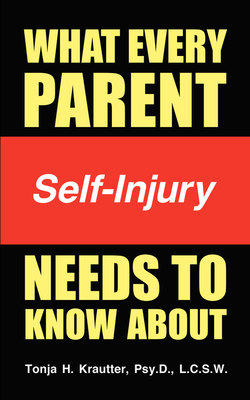Читать книгу What Every Parent Needs to Know About Self-Injury - Tonja Krautter - Страница 7
На сайте Литреса книга снята с продажи.
Escalation
ОглавлениеAlthough cutting and burning are the most commonly reported types of self-injurious behavior, there are others. For example, the person may scratch, hit, bite, kick, head bang, and/or pull out hair. These secondary types of self-injurious behavior are often considered gateway behaviors to other, more severe forms of harm. In other words, someone may begin self-injuring using one of the methods listed above, and then move to a more severe form of self-injurious behavior. In the most extreme cases, an individual might break their bones, amputate a limb or inject toxins into their body. Although these behaviors are not common, they do occur.
There are various reasons why an individual might transition to a more severe form of self-injurious behavior. The two most cited reasons are: (1) to achieve greater mastery over distressful feelings, and (2) because superficial wounds do not provide the same “high” as do more severe wounds. In both cases, the individual increases the severity of bodily harm to achieve a specific goal.
Amber remembers making this transition. She clearly recalls her first time inflicting bodily harm. She writes, “Self-injury controlled my life for the better part of eight or nine months and what started it all I will never forget. I had a bad day at field hockey practice and I had finally had enough. Between pressures from school, my mom, field hockey and trying to deal with my own inner turmoil, I finally snapped. I came home so angry and so hurt; I didn’t know how to let it out. I could feel the tension growing inside me, just getting worse and worse and so I did the only thing that made sense to me. I began to hit myself with my hockey stick. I mostly stuck to my feet and ankles, but I hit my hands some too.
It didn’t make me feel better though. I needed more. So I went to the kitchen, got the sharpest knife I could find, and slowly ran it over my ankles. It was weird because I actually started to feel better. All that tension that was rising inside of me was released and seemed to flow out of me along with the blood. Hurting myself, at the time, was the only thing that made me feel better. From that time on, whenever something bad happened, I’d run right for the closest knife and start cutting.”
